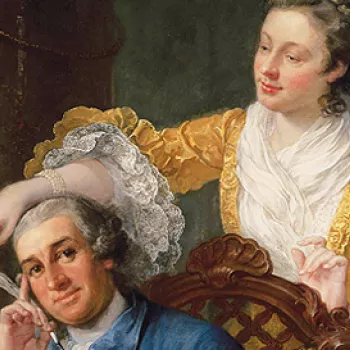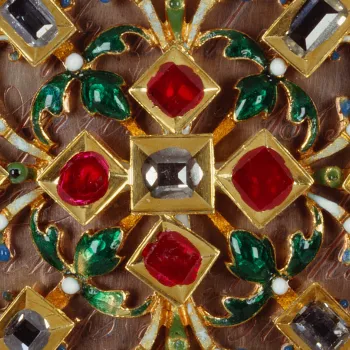Elizabeth I Cameo: c. 1575-85; Mount: early 18th c.
Sardonyx: brown and white; open gold mount with claw settings, suspension loop and ring | 6.7 x 5.5 cm (cameo) | RCIN 65186
-
Cameo of a bust of Elizabeth I (1533-1603) in three-quarter view with her head in profile to the left. She wears an elaborate low-cut gown with square neckline and a high lace ruff. A double-looped chain and pendant hangs around her neck. The raised border is bevelled to reveal the layers of the stone.
Extensive studies of the Tudor portrait cameos, in particular those representing Elizabeth I, have identified overwhelming numbers, leading to the assumption of a special form of large organized court workshop. The cameos vary in size, this being one of a group of six with the largest dimensions, all of which are of superb quality. The others are in the Cabinet des Médailles, Paris, the State Hermitage Museum, St Petersburg, the Victoria & Albert Museum, London, the Devonshire collection, Chatsworth House and the Kunsthistorisches Museum, Vienna.
The cameos were principally used as presents to foreign monarchs or loyal servants: Sir Francis Walsingham is depicted wearing a cameo of the Queen of the same type and size in a portrait of c. 1587; Sir Christopher Hatton is similarly shown wearing a cameo of the Queen on his gold chains, c. 1585. These un-ageing images, which are always of the same general format, would certainly have contributed to the burgeoning cult of the Virgin Queen.
This cameo was among the objects catalogued by Horace Walpole in 1763 and described as a ‘great numbers of cameos and intaglios, few good’. Walpole noted that this and another cameo of Elizabeth I (RCIN 65187) were of especial quality and attributed them to the Italian cutter Valerio Belli (c.1468-1553/5), or Vincentino as he was called in the eighteenth century. This attribution seems to have derived from John Evelyn, who in 1653 commented that he had seen a head of Elizabeth I, ‘in a rare sardonyx, cut by a famous Italian’, adding that Belli ‘had been in England at the time of Queen Elizabeth’ and had created the cameo for the musician, Jerome Laniere. Evelyn, who later commented that the cameo was ‘now in his Majesty’s cabinet’, had met Laniere who assured him that the image ‘was exceedingly like her’. The attribution is impossible - Belli died in 1553/5 - but it was retained by Walpole, perhaps because Belli was one of the few stone cutters whose career is treated in Vasari’s Lives. The mastermind behind this cameo workshop production has not been established and it has been suggested that nothing is known about these workshops because they were intentionally surrounded by secrecy. However, the cameos were clearly produced either by a foreigner working in England or an English artist trained abroad. An engraver of this capacity can only have originated in Italy.
An antiquarian interest in the Tudors was rekindled in the first decades of the 18th century and copies of medals were struck or reinvented in their honour. The Paris cameo of Elizabeth I was copied in 1878 by M. Bissinger and was shown at the International Exhibition in Paris that year.
Text adapted from Ancient and Modern Gems and Jewels in the Collection of Her Majesty The Queen, London, 2008 and The First Georgians; Art and Monarchy 1714 - 1760, London, 2014.Provenance
This cameo was probably the larger of the two of Elizabeth I noted by Horace Walpole as ‘2 of Eliz ... the larger good at Kensington Palace in 1763 in his list of ‘Other pictures & curiosities’ of the late Queen Caroline, consort of George II, in a cabinet at Kensington Palace. It was also among the curiosities sent from Kensington to her grandson, George III, by Walpole on 22 March 1764 (RA GEO/Add.Ms.16).
-
Medium and techniques
Sardonyx: brown and white; open gold mount with claw settings, suspension loop and ring
Measurements
6.7 x 5.5 cm (cameo)











